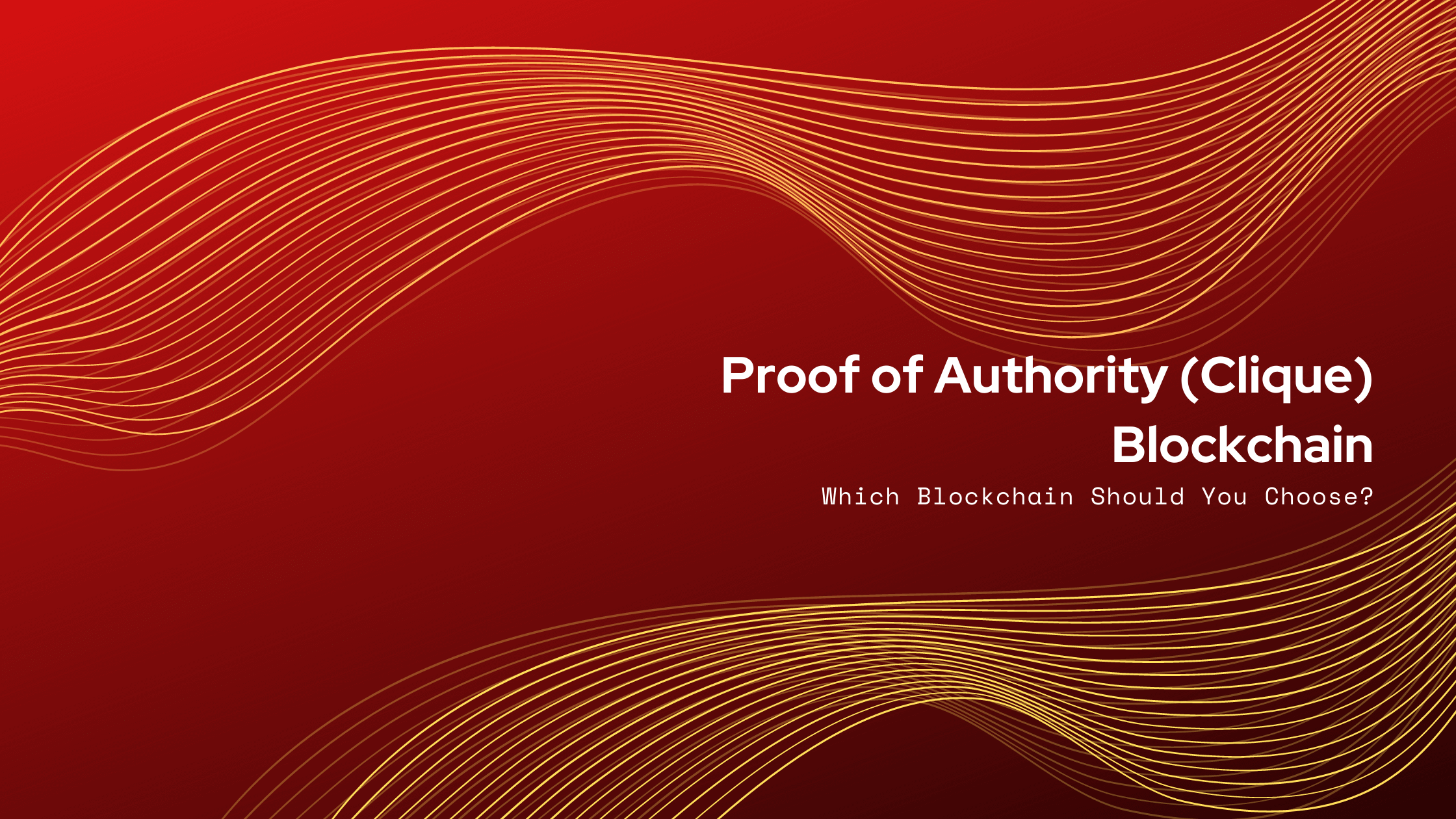Energy consumption is the tricky part of operating a blockchain-based business software or system. Private blockchain running on Ethereum Proof of Authority (PoA) blockchain resolves this challenge.
This article will help you understand the contrast between private and public blockchain, why Ethereum is the best choice for private blockchain, and how PoA (Clique) helps you as an Ethereum consensus protocol.
Which Blockchain Should You Choose?
Blockchain industry specialists and users consider Ethereum (ETH) smart contract as the leading platform. You can launch any decentralized apps (DApps) or Web3 interfaces using the ETH blockchain.
Without the development of the ETH blockchain, cryptocurrencies would have still been peer-to-peer currency. The availability of the ETH blockchain network enabled the global mass population to run apps or systems on ETH virtual machine (EVM.) The outcome is more accessible DApps for developers and users.
The ETH blockchain platform uses highly secure 256-bit data transmission encryption that makes this smart contract virtually unhackable. The smart contract platform is compatible with ERC1400, ERC20, and ERC721.
ETH smart contract is highly beneficial for businesses and collaborative partnerships. ETH supports and executes the partner contracts as per a set of rules.
Though ETH is the most reliable and trusted blockchain for smart contract execution, you could take a look at the following Ethereum (ETH) alternatives:
1. Hyperledger
It is an open-source blockchain platform to run smart contracts. Hyperledger is a result of global leading technology company partnerships. The list of tech giants includes ConsenSys, R3, Cisco, Hitachi, IBM, NTT Data, Intel, RedHat, VMware, etc.
It supports multiple distributions like Hyperledger Fabric, Hyperledger Burrow, Hyperledger Sawtooth, and Hyperledger Indy. It also offers compatibility with many plug-ins and programming languages.
The developers of the Hyperledger Fabric blockchain platform offer tools like Hyperledger composer, Javascript-based tools, etc. These tools help in managing the decentralized ledger or smart contracts. Ethereum also offers such tools.
2. Cardano
It is a blockchain platform developed with a focus on scientific research into the blockchain. Since the blockchain platform is free for commercial and personal use, developers can modify Cardano as per their projects.
Ouroboros PoS consensus protocol makes Cardano a better choice over other blockchains when scaling up your private blockchain system.
3. TRON
It is a blockchain network based on Solidity and can execute many smart contracts quickly than other similar blockchains. Because of its features like transparent governance, interoperability, and safety, both public and private blockchain can use TRON.
TRON blockchain runs on TRON virtual machine. The smart contracts that run on the TRON blockchain follow the Proof of Stake consensus protocol.
4. Tezos
It is an open-source blockchain platform for asset digitization and DApps. Terms like builders, bakers, and researchers denote the community members who validate transactions or smart contract executions in the Tezos blockchain.
Tezos is a self-governing smart-contract-based blockchain. Smart contract executions in this blockchain network follow the Proof of Stake consensus protocol.
5. NEO
OnChain, a Shanghai-based blockchain company, built the NEO smart contract platform. Globally it is known as the Ethereum of China. Solidity programming language is the basis of this blockchain network.
The platform utilizes the Byzantine Fault Tolerance (dBFT) algorithm and Proof of Stake consensus protocol. It is cheaper to manage than Ethereum.
6. NEM
This blockchain started its journey in 2015 and since then got popularity among blockchain developers as the programming language is simple and based on Java. The Mijin V.2 updates of this blockchain network increased its security, speed, and scalability.
While Ethereum can handle only 15 transactions per second, NEM clocks much better in terms of speed. It can resolve up to 100 transactions per second.
Which Consensus Protocol Do You Need to Use?
As blockchain is a decentralized system, anyone on the network can submit a piece of data for storage. However, there are systems in place so that the nodes in the blockchain network could come to an agreement to decide whether to store the data or not.
These systems are consensus protocols. There are different types of consensus protocols. The comparison below will help you choose the perfect consensus protocol for your private blockchain entity:
1. Should You Settle for Proof of Work (PoW)?
A significant challenge that could compromise the security of Ethereum-like blockchains is that anyone with more than 51% mining resource could gain complete control of the distributed ledger.
The issue shows connectivity with the Proof of Work (PoW) style consensus protocol for smart contract execution. Power usage is also a big challenge. For example, the Bitcoin blockchain consumes electricity equivalent to a small country.
For private blockchain requirements, Proof of Work (PoW) is not the appropriate consensus protocol.
2. Should You Choose Proof of Stake (PoS)?
To resolve the operational challenges of a public blockchain, Ethereum transitioned to the Proof of Stake (PoS) consensus protocol. It mitigates a few issues that arise from Proof of Work (PoW).
The validator or miner will deposit a specific amount of ether into the smart contract. If the network finds the miner to be fraudulent, it will lock away the initially deposited ether.
Proof of Stake (PoS) consensus protocol also addresses the hacking issue with 51% mining resources as well as the power consumption for transaction validation. For private blockchain, you could say that Proof of Stake (PoS) is better than Proof of Work (PoW).
However, blockchain for businesses is much more critical and investments are at stake here. Therefore, Proof of Stake (PoS) does not offer much security and trust that the private blockchains need.
If someone has some ether and attaches sufficient ether into the validator smart contract, anyone can become a validator in the blockchain. It compromises the data security of any private blockchain.
3. Definitely Go for Proof of Authority (PoA)
Proof of Authority (PoA) is the latest consensus protocol added to the Ethereum blockchain. You’ll need to create multiple pre-approved nodes with blockchain network access authority. These are sealer nodes.
Currently approved nodes will have to vote when you want to add a new node. As a result, you get complete control to decide which node can mine or seal blocks in your private blockchain network.
Any pre-authenticated signer can only vote once. It eliminates the chance of one malicious or rogue node causing too much damage to the blockchain. Authority nodes will have to apply consensus when you need to remove a node from the system.
The Rinkeby test network is currently using Proof of Authority (PoA) for smart contract execution on the Ethereum blockchain. Proof of Authority (PoA) is otherwise known as the Clique consensus protocol on ETH blockchain.
How Do Public and Private Blockchain Differ From Each Other?
Public and private are the two types of blockchain that you can find in existence. Each of these blockchains impacts businesses in unique ways. However, which blockchain you need will depend on your business and revenue model.
Most enterprises and companies chose private blockchain over the public as the former offers stringent security, cost savings, and control over data. Here is how private blockchain differs from the public blockchain:
1. Transaction Charges
There tends to be a higher number of nodes in the public blockchain than the private ones. It increases the network bandwidth consumption in the public blockchain. As the speed of the transaction decreases, the cost of the transaction eventually increases.
More nodes mean more power usage, which further increases the transaction cost in the public blockchain.
A private blockchain is cost-effective, and virtually there are no transaction fees.
2. Control Over Blockchain Network
A public blockchain is a truly decentralized network where there is no existence of one entity controlling the blockchain. Each node or user group gets uniform controlling authority over the entire network.
On the private blockchain, you get to monitor the entire blockchain. Furthermore, a set of pre-authenticated nodes need to vote on a consensus to happen.
3. Consensus Protocol
For complete consensus across the organization, you need to use a public blockchain system for your business. In terms of permissions, nodes, and networks, each user enjoys equal rights.
The private blockchain will however restrict new node access unless pre-authenticated nodes vote for the entry of the new node. Consequentially, until the authenticated nodes reach a consensus, transactions won’t take place.
4. Transaction Speed
Any node can access the public blockchain. As more nodes connect to the same network mining or other transaction resolution becomes slow. However, if you use private blockchain for your business, you can enjoy faster transaction resolution.
5. Ledger Immutability
The gold standard of blockchain security and authenticity is immutability. A public blockchain offers total immutability. Once you insert a block in the public blockchain, there is no way to undo it.
On the private blockchain, the network blocks are partially immutable. The blockchain central command has the ability to introduce changes in the ledger.


